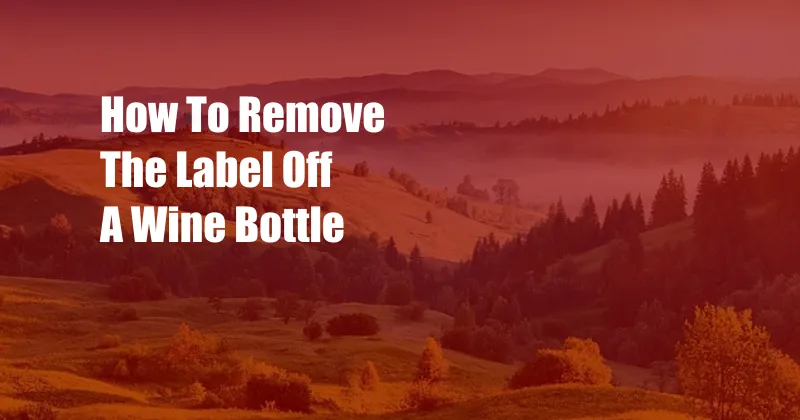
**The Art of Removing a Wine Label: Unveiling the Bottle’s Essence**
Once upon a time, I stumbled upon a hidden gem at a flea market – an antique wine bottle with an alluring label that evoked a bygone era. Eager to uncover its secrets, I embarked on a meticulous journey to remove the label without damaging the bottle or diminishing its historical charm. Thus, I present to you a comprehensive guide to the art of removing wine labels, empowering you to unveil the stories and beauty concealed within these bottles.
Delving into the history of wine labels, we find that they were initially used as a means of identification, providing information about the wine’s origin, vintage, and producer. Over time, they evolved into artistic expressions, showcasing elaborate designs and intricate typography. Today, wine labels hold both practical and aesthetic value, serving as a testament to the winemaking process and the spirit of the region.
**The Gentle Approach: Removing the Label Intact**
If preserving the label is paramount, the water method proves most effective. Submerge the bottle in a basin filled with lukewarm water, ensuring the label is completely submerged. Allow the bottle to soak for about 30 minutes, enabling the adhesive to loosen. With gentle hands, carefully peel off the label, starting from the edges and working your way towards the center. Rinse the bottle thoroughly with water to remove any remaining adhesive residue.
Alternatively, heat can gently coax the label to release its grip. Using a hairdryer on its lowest setting, slowly direct the warm air onto the label. As the adhesive softens, carefully lift a corner of the label and gradually peel it off. This technique is particularly effective for labels adhered with synthetic glue that responds well to heat.
**The Thorough Method: Removing All Label Traces**
For a pristine and label-free surface, nothing surpasses a thorough approach. Begin by soaking the bottle in hot water for an extended period, approximately two hours. This extended soaking will allow the adhesive to break down and soften further. Once the label has been removed, remnants of adhesive may still linger. To remove these stubborn residues, reach for a solvent like acetone or rubbing alcohol. Apply the solvent cautiously to a cotton ball or soft cloth and gently rub away the remaining adhesive. Rinse the bottle thoroughly with water to ensure no solvent traces remain.
Another effective solution for removing adhesive residues is a homemade mixture of equal parts baking soda and vegetable oil. Form a paste and apply it to the affected area. Let it sit for about 15 minutes before gently scrubbing with a soft brush or cloth. Rinse the bottle with water to remove any lingering residue.
**Expert Tips for Label Removal Mastery**
Soak Thoroughly: Patience is a virtue, especially when removing wine labels. Allow the bottle to soak for ample time, allowing the adhesive to loosen completely. Impatient peeling can lead to tearing and damage.
Start from Edges: When peeling off the label, begin from the edges and work towards the center. This prevents the label from rolling or creasing, ensuring its integrity.
Use Warm Water: Hot water significantly softens the adhesive, making label removal easier and less likely to damage the paper or the bottle.
Test Solvents First: Before applying solvents to remove adhesive residues, always test them on an inconspicuous area of the bottle to ensure they do not cause discoloration or damage.
Rinse Thoroughly: After removing the label and any adhesive traces, rinse the bottle thoroughly with water. This eliminates any lingering solvent or residue, leaving behind a pristine surface.
**FAQs on Wine Label Removal**
Q: Can I reuse wine bottles after removing the labels?
A: Yes, once the labels are removed, the bottles can be thoroughly cleaned and sanitized, making them suitable for reuse.
Q: Are there any labels that cannot be removed?
A: Most wine labels can be removed using the techniques described above. However, some labels may be bonded with particularly strong adhesives or have intricate designs that can be challenging to remove without damaging them.
Q: Can I remove the foil capsule on top of the bottle?
A: Yes, you can remove the foil capsule by carefully cutting around the base with a sharp knife or using a foil cutter. Avoid using excessive force, as it may damage the cork or the bottle’s lip.
**Unveiling the Wine’s Story: A Call to Action**
Removing a wine label is akin to uncovering a hidden chapter in a timeless story. Whether you seek to preserve the label’s charm or completely remove its presence, the methods described above will guide you towards a successful outcome. So, embark on this enchanting journey, uncover the intriguing tales locked within wine bottles, and delve into the captivating world of wine and its rich history.
Are you eager to explore the fascinating realm of wine label removal further? Share your thoughts, questions, and experiences in the comments below. Let’s delve deeper into the art of unveiling the secrets concealed within these elegant bottles.